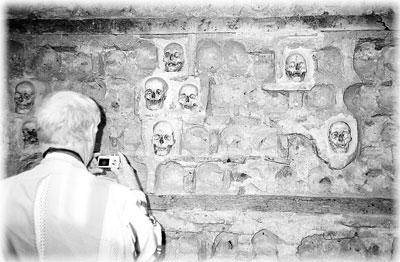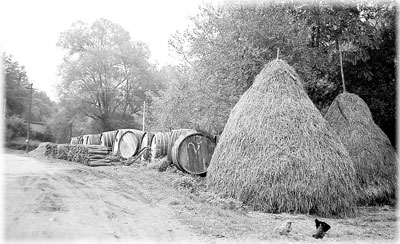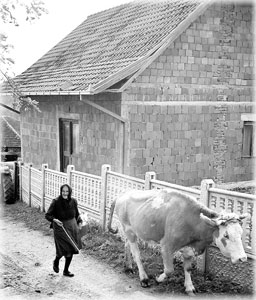Travels in central Serbia
by Margaret and Roger Kinkle, Oro Valley, AZ
For 10 days in early October ’05 we visited friends in south-central Serbia & Montenegro, touring three historic sites in Serbia: Niš in south-central Serbia; Felix Romuliana at Gamzigrad near Zaječar in eastern Serbia, and Staro Selo (Old Village), south of Užice in western Serbia.
Getting there
We flew Air France from Atlanta to Paris to Belgrade, where our friends met us at the airport. Citizens of the U.S. do not need a visitor’s visa to visit for a short time.
Because we were staying in a private home and not in a hotel, our hosts had to take our passports to the local police station and register us upon arrival and log us out upon our departure; this appeared to be only a formality and caused no problems. There was no departure tax on leaving from the Belgrade airport.
Our travels took us near the Južna (southern) Morava, Zapadna (western) Morava, Detinja and Timok rivers. Our friends drove us on small unnumbered country roads so we could see the picturesque peasant villages.
Sights in and around Niš
Niš is a modern city of over 200,000 people in south-central Serbia. The area around Niš (pronounced “Neesh”) has been inhabited since the Bronze Age. We visited three historical sites there.
Villa Rustica
Under the Roman Empire, the city of Niš was named Naissus. The Roman emperor Constantine the Great was born there in the late third century, and he made Naissus an important economic, military and administrative center. He constructed many buildings, including an imperial villa used for his visits to the city.
Located at Mediana on the outskirts of Niš, the ruin of Constantine’s Villa Rustica is an important archaeological site currently undergoing excavation by the Serbian government.
We walked around a columned courtyard with pool, once surrounded by dwellings for the people who lived at the villa as well as for visitors. Mosaic floors and remains of marble columns were in the process of being exposed. Pieces of marble statues and other finds are preserved in the archaeological museum on site. Admission was 50 dinars (about 70¢).
The Fortress of Niš
Located in downtown Niš, the fortress was erected on the site of earlier Roman, Byzantine and medieval fortifications. Most of the extant fortress is of Turkish origin, dating from around 1720. Within the fortress is a grassy park surrounded by galleries, souvenir stores and a coffee shop — all built into the massive stone walls of the fortress.
The Tower of Skulls
Located within the city limits, this is a gruesome sight commemorating a violent period in Serbian history. In 1809, during a rebellion of Serbs against an overwhelming force of occupying Turks, a group of Serbian army officers blew up their gunpowder depot, killing themselves and, reportedly, 4,000 Serbian soldiers and 10,000 members of the surrounding Turkish army.
To frighten the populace, the Turkish sultan had the heads of approximately 1,000 dead Serbs cut off and mounted into a stone tower about 20 feet high. The tower stood exposed to the elements for years, during which time most of the skulls were lost or eventually removed to be buried elsewhere.
In 1892, a memorial was built around the tower to protect the remaining skulls, which number 58 today. Inside the memorial, we read, in English, details about the history of the battle. Admission was less than $1.
Sights near Zaječar
Felix Romuliana
The extensive Roman ruin of Felix Romuliana at Gamzigrad is currently being excavated. We were the only visitors on the afternoon we were there.
Roman emperor Gaius Galerius Valerius Maximinianus had it built for himself and named it for his mother, Romula. It’s an impressive ruin with uncovered mosaic floors, columns, arches and buildings. Part of the enclosing wall still stands.
There are two mausoleums on a hill overlooking the ruin that house the remains of the emperor and his mother. Admission to the ruins was 50 dinars (about 70¢).
Sights in the Zlatibor mountain region
The Zlatibor (“Golden Pine”) mountain region lies on Serbia’s border with Bosnia & Herzegovina, west and southwest of Užice. We made stops at two “old” villages in the area — one constructed to look old and the other one, genuine.
Ethno-village at Mokra Gora
The ethno-village at Mokra Gora is a cluster of new buildings constructed in the style of an old mountain village by local film producer Emir Kusturica. The village functions as a center for seminars, films and art exhibits and is a popular excursion site for school groups. Admission was 160 dinars, about $2.25.
The gift shop sells interesting craft items, many locally made. There is a coffee shop, with coffee and pastries costing about $3 per person.
The architecture is interesting, but the happenings at Mokra Gora cannot be fully appreciated unless you understand the Serbian language.
Staro Selo
About a 30-minute drive south from Užice, through hills of high pasture and forests, lies the community of Sirogojno (pronounced “Siro-goino) and the folkloric park and open-air museum named Staro Selo (Old Village), seemingly isolated by centuries from the modern world.
The church and some of the houses, barns and other buildings in the park have stood there for over 200 years. Additional old houses and buildings were brought in from the countryside to complete the collection.
Admission was 160 dinars per person. This park is also popular with school groups.
The park is large, and we arrived with only a couple of hours of daylight remaining to see it. However, it is worth spending at least a half day to explore and appreciate the static exhibits of spinning, weaving, pottery making, dairy production, beekeeping and other farm activities as they were carried out in the 1700s and 1800s.
A brochure available in English lists each building and describes what it was used for. Each building was numbered, but it was hard for us to locate the numbers. Only with our Serb hosts’ explanations could we fully understand what we were seeing.
The gift shop at Staro Selo sold sweaters, scarves, socks and mittens woven by local women, kilim rugs with local designs, locally made wooden kitchen crafts and Christmas ornaments made of a kind of hardened bread dough, plus many other ethnic items. We bought some Christmas tree ornaments for less than $2 each.
The park also has a good inn specializing in Serbian country food, which is delicious but is full of cholesterol and calories. Our multicourse dinner cost less than $40 for four people, including a bottle of wine.
This open-air museum is isolated and may be difficult to reach during the winter months. For more information, including accommodations, call +381 (0)31 802 586 or visit www.sirogojno.org.yu.
Serbian food
During our visit, paprikas were in season, and farmers alongside all the highways were selling bags of the peppers; we smelled the aroma of roasting paprikas in many places. Women were making and canning ajvar (pronounced “eye-var”), a paprika-and-garlic mixture sometimes including eggplant. Freshly roasted paprikas with oil and garlic were served with every meal.
Other foods included Russian potato salad, homemade farmer’s cheese, pita (phyllo dough with cheese or other fillings), palacinka (crepe filled with jam), spaghetti with oil and salami, fresh garden vegetables and various meat dishes, including roast pork, ham and turkey.
Whenever our hosts took us to the houses of their friends, the friends always invited us to have nešto slatko (something sweet). They would bring out a tray that had a glass of water and a spoon for every guest. The “slatko” would be a bowl of homemade fruit preserves, honey or something similar. The protocol was that each person would take a spoonful of the sweets, drink some of the water and then put the used spoon into his water glass. Then the tray would be offered to the next guest.
Serbia as a travel destination
Other than in the three major cities of Belgrade, Niš and Novi Sad, Serbia does not appear to have the infrastructure to comfortably accommodate large groups of North American travelers. Acceptable hotels and restaurants may be present, but they aren’t easily located. Individual travelers or backpackers would do better than tour groups.
Serbia uses primarily the Cyrillic alphabet, although Belgrade and scattered towns have some Latin script.
Euros are not used in Serbia. The exchange rate was 71 dinars per dollar while we were there. The currency is not convertible outside of the country. We got dinars at an ATM, using our debit card. ATMs are located in front of downtown banks and are easy to find in large and moderate-size cities and towns.
At the time of our visit, gasoline cost 77 dinars per liter, or about $4.40 per gallon, which seems a bargain compared to prices in Western Europe. Twenty-year-old Yugo and Zastava cars belching leaded gasoline fumes are the main means of transportation in towns. Air pollution from cars, factories and agricultural burning is severe in some places.
It appeared to us that the majority of people smoke.
We saw some structures in Belgrade bombed by NATO during 1999 that are still in a state of disrepair.
The rural countryside of south-central Serbia is beautiful, with rivers winding among the hills. However, the people in rural areas seem to be living several decades behind those in Western Europe. Their lifestyle seemed quaint to us, but this situation will undoubtedly change as the country approaches admission to the European Union.
Serbia outside of Belgrade has potential for tourism, possibly in the near future, but we were glad to see it before it is “discovered.” And we are especially glad to have good friends who went out of their way to show us the beauty of their country.




